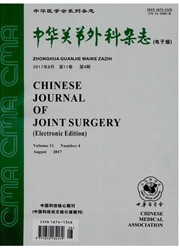

 中文摘要:
中文摘要:
目的 探讨应用术前激光地面简易标记定位减少术中透视次数及相关风险的价值。方法 对2010年2月至2014年2月在中山大学附属第一医院关节外科收治的73例EvansⅠ-Ⅳ型老年股骨间粗隆骨折予动力髋螺钉(DHS)手术的患者进行了比较研究,根据简单随机化法将患者分为术前激光地面简易标记定位组(简易定位组)共39例,术中经验透视组(对照组)共34例,运用卡方检验及独立样本t检验分别比较两组患者在术中计数资料如透视次数、术后感染发生率,计量资料如术中透视时间、出血量等方面的差异。结果 术中透视次数,简易定位组的(6.1±1.7)次较对照组(9.3±2.7)次减少,差异有统计学意义(t=6.591,P〈0.05);术中透视时间,简易定位组的(9.4±2.1)min较对照组(16.3±3.1)min降低,且有统计学意义(t=11.807,P〈0.05);出血量,简易定位组的(160.3±50.1)ml较对照组(215.4±55.2)ml减少,且差异有统计学意义(t=5.857,P〈0.05),而简易定位组无术后切口感染病例,对照组出现2例术后切口感染,但无统计学意义(P〉0.05)。结论术前地面标志激光简易定位能减少术中透视次数、术中透视时间、术中出血、术后感染发生率,从而减少X线暴露,值得推广。
 英文摘要:
英文摘要:
Objective To explore the value of laser on ground for reducing intraoperative X-ray examinations and the related risks. Methods This study was conducted on 73 elderly patients with intertrochanterie fractures ( Evans I- IV ) from February 2010 to February 2014 in the First Affiliated Hospital of Sun Yat-sen university and all the patients had dynamic hip screw (DHS) surgery. According to simple randomization method, the patients were derided into two groups: preoperative localization by laser on ground was used for the easy location group (39 cases) and the control group (34 cases ) were intraoperative localized by experience. The times of intraoperative X-ray examination, the duration of intraoperative X-ray exposure, blood lossand the incidence of postoperative infection were comparedby chisquare test and student t test, respectively. Results In the easy location group, the times of intraoperative X-ray examination ( 6. 1 ± 1.7 ) was less than the control group ( 9. 3 ± 2. 7 ), with statistical significance (t =6. 591, P 〈0. 05). The duration of intraoperative X-ray exposure in the easy location group (9.4± 2. 1 ) min was less than the control group ( 16. 3 ±3.1 ) min with statistical significance (t = 11. 807, P 〈 0. 05 ). The blood loss volume in the easy location group (160. 3 ± 50. 1 ) ml was less than the control group ( 215.4 ± 55.2) ml with statistical significance ( t = 5. 857, P 〈 0. 05 ). The easy location group had no postoperative infection, while the control group had two cases of postoperative infection; the difference was not statistically significant (P 〉 0. 05). Conclusion Preoperative localization by laser on the ground can reduce the times of intraoperative X-ray examination, shorten the duration of intraoperative X-ray exposure and decrease the incidence of postoperative infection, which is worthy of application.
 同期刊论文项目
同期刊论文项目
 同项目期刊论文
同项目期刊论文
 期刊信息
期刊信息
